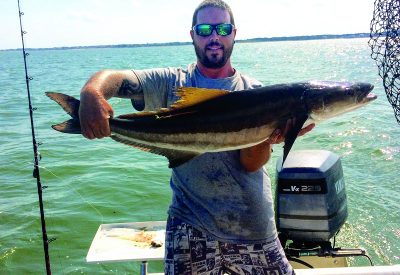By Dr. Julie Ball, IGFA Representative, Virginia Beach
Afternoon thunderstorms and escalating heat are typical for this time of the year, but in general the weather is mostly fishable.
Cobia is always a top player in the local summer-time fishing line-up. Anglers are grateful for yet another season after emerging through another harsh barrage of cobia regulations. A good summer with limits of respectable fish will make it worth the hassle. Cobia are easy to come by this month as they are easily spotted cruising in lower Chesapeake Bay waters. Most cobia will range around 30 to 45-pounds, with scattered 60 to 70-pounders in the mix. Chummers will also make their mark as their slicks of menhaden entice good numbers of decent fish into their spreads. But, the word on the dock is that some very large and toothy sharks are also responding to these chum slicks in bay waters this year. A Recreational Cobia Permit is required this year, and all cobia catches and cobia fishing activity must be reported. These permits can be obtained via the VMRC website at mrc.virginia.gov, or at any local MRC Licensing Agent. The official cobia season spans from June 1st to September 15th this year.
Red drum will spread out into bay waters as they leave the Eastern Shore shoals, providing top water casting opportunities as they school around the mouth of the bay, especially near the Baltimore Channel. Sporadic jack crevelle sightings and hook-ups are also common around the mouth of the bay this time of year.
The flounder action in the Chesapeake Bay can be productive in July, with both jigs and live bait effective. Anglers working their offerings around the four islands of the Bay Bridge-Tunnel can find flatfish averaging around 20 to 22-inches on most decent days this month. Anglers drifting with strip baits and minnows can also find good numbers of fish near the Hampton Bar and Thimble Shoal Channel. Both Lynnhaven and Rudee Inlets are always good locations to try in July.
Along the span of the Bay Bridge-Tunnel, sheepshead anglers will find success using fiddler crabs or clams as bait, with many fish weighing in at over 10-pounds. Aggressive triggerfish will also take offerings in the same areas. Spadefish are out on force this year, with a nicer class of fish pushing to around 8-pounds available around the islands and pilings of the Bay Bridge-Tunnel, at the Chesapeake Light Tower, the Tower Reef, and several inshore wrecks. Inshore wrecks are also harboring some nice seabass, triggerfish and flounder.
Spanish mackerel are very active along the coastlines from Cape Henry to Sandbridge, available for trollers pulling small spoons. A few king mackerel sightings are common this time of year, but the action will improve later in the season.
Croaker are always a favorite this time of year, with good catches reported from most everywhere from the Hampton Roads Bridge-Tunnel to Cape Henry. The hardhead bite out of Oyster will develop mid-month. Some nice fish also come from Rudee and Lynnhaven. Puppy drum and speckled trout are also still possibilities in the shallows and inlets.
Virginia tarpon will tempt only hard-core anglers to the back waters of Oyster, where sightings and hook-ups are common this time of year. If you go, be prepared to also tangle with exhausting big Southern rays and big mean bull sharks in the hot sun, all while battling the infamous Eastern Shore biting flies.
Deep dropping is still a good choice in July, with quality blueline tilefish, golden tilefish, black bellied rosefish, and nice grouper on the menu. Jumbo black seabass are also available mixed in with the tilefish. Amberjack are circling offshore wrecks and at the Southern Towers, but most anglers are not interested in batting these powerful wreck donkeys.
The offshore bite is often good this month, with most action likely centered around chasing the popular yellowfin tuna. Some yellowfin can range to around 50 to 70-pounds, with even larger bigeye tuna on the loose. Mahi should be a crowd-pleaser for most of the summer, and wahoo action will also improve over the next few months. For billfish anglers, scattered white marlin are around this month, but this action improves in August and September.
